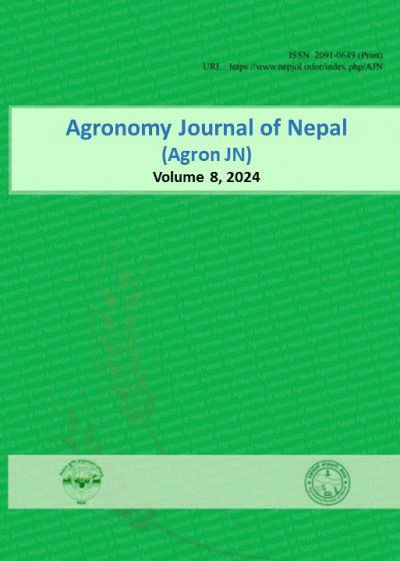Genotype by Environment Interaction Using AMMI, GGE Biplot and Multivariate Analysis of Nepalese Aromatic Rice Landraces
DOI:
https://doi.org/10.3126/ajn.v8i1.70767Keywords:
Aromatic rice, AMMI, GGE biplot, landraces, PCA, stability analysisAbstract
Aromatic group of rice comprises fine, medium, long and extra-long grain that has rich in agro-biodiversity, carries historical and cultural significance in Nepalese society. The objective was to identify stable, high-yielding aromatic rice landraces for Nepal Thirty aromatic rice landraces including two released varieties as standard checks were evaluated at three locations during 2020 and 2021. The experiment was laid out in a Randomized Complete Block Design with three replications. The combined analysis of variance indicated differences among genotypes and genotype-environment interactions for grain yield. The additive main effects and multiplicative interaction (AMMI) analysis revealed that genotypic effects for 69%, genotype × environment interaction effects for 28% and environmental effects accounted for 3% of the total sum of squares. Similarly, GGE biplot analysis showed that the principal components (PC1 and PC2) accounted for 53% and 47% of the GGE sum of squares, respectively. Based on AMMI1, AMMI2 biplots, and GGE biplots, the genotypes Samba Masuli Sub-1 and Sugandhit Dhan-1 were identified as the high yielding and stable fine and aromatic rice landraces. Other promising genotypes are Damari Dhan, Tilki, Hiupuri, Kalo Basmati, Gouriya, and Brahmamusi Dhan. Specifically, Samba Masuli Sub-1 demonstrated the highest grain yield performance at the NRRP, Hardinath, while Sunaulo Sugandha and Balamsari Dhan excelled in the Tarahara and Khajura environments, respectively. In PCA analysis, four PCs showed significant eigen value >1.0 contributing more than 84% of total variance. Biplot analysis reflected that 1000 grain weight, panicle length, heading and maturity days, and grain yield showed greater variation among the landraces. The results provide a robust basis for the further evaluation and verification of this findings in advance stage trials. The superior and outstanding landraces with higher yields and aroma are potential future varieties that can be either use directly as varieties after selection or utilize in future breeding programs for the development of new aromatic rice varieties.
Downloads
Downloads
Published
How to Cite
Issue
Section
License
Copyright (c) 2024 Agronomy Society of Nepal (ASoN)

This work is licensed under a Creative Commons Attribution-NonCommercial 4.0 International License.
ASON permits for free use, distribution and reproduction in any medium if the original work is properly cited and not used for commercial purposes.




